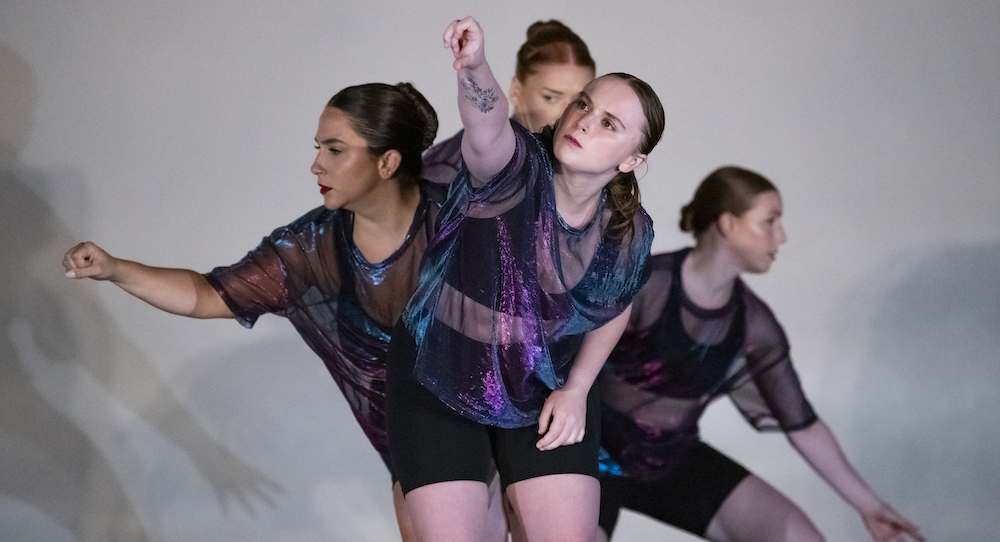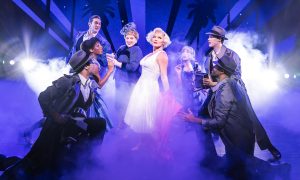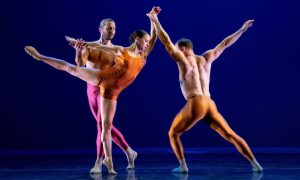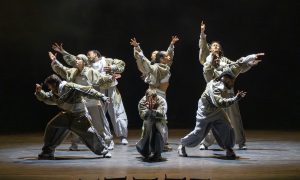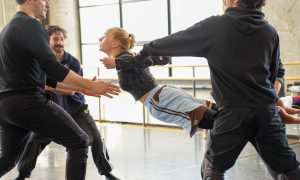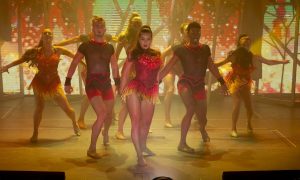Mass Motion Dance, Brighton, MA.
July 13, 2024 (viewed digitally).
Sometimes dance succeeds on an aesthetic/kinesthetic level – offering something that’s pleasing to experience. Sometimes it accomplishes something more cerebral, provoking thought and challenging preconceptions. The dance that gets me on my feet after the last bow, and stays with me long after I leave the venue, makes an impact in both domains.
That was Nozama Dance Collective’s N2 2024. The company has always been bold, intentional and technically capable. This program demonstrated the company’s expanding ability to both satisfy aesthetic senses and tickle curious minds. In addition to the below, they also performed an excerpt of Artistic Director Dana Alsamsam’s evocative, imagistic Untold, Retold.
Olivia Moriarty’s tenacious and thoughtful Un(I)form successfully set the tone for the program. As Billie Eilish’s score challenged cultural opinions of how women show up in the world, the dancers began moving from a crisp formation: angular, resolute. They demonstrated stellar musicality through various timing structures. Just as much, they exuded bold physicality.
As the score shifted to the speaker taking more “I” statements, claiming more than questioning, the ensemble danced out from the formation and moved in their own tenacious ways. Quite fittingly, the work concluded with one dancing independently – quickly, passionately, frenetically – while the larger ensemble moved in unison, much more slowly and in a more controlled manner. Who’s to say that what she offered was worth any less than what they collectively did?
Actualization, by Katie Logan in collaboration with the dancers, was equal parts softly reflective and kinetically fierce. The title did certainly have me thinking of the idea of “self-actualization,” and the piece seemed to embody that idea. The dancers opened the work by coming straight forward from a horizontal line, each moving with honesty. Through sharing weight, they found support in one another. Yet also, particularly toward the latter part of the work, they discovered their own ways to be in their body and in space. Their white costumes spoke to open possibility.
They traveled their own journey, in parallel to one another – as we all must do. As was true of the program at large, inventive shape and movement pathway kept me intrigued throughout – the big idea of “self-actualization” aside. I was also reminded here: these artists seem to never get stuck in how other artists have inspired them or in what they themselves have done before.
Alsamsam’s DYSTOPIC brought more edgy mystery, with its own kinetic flavor. The score (by Lorn) had such a clear pulsing rhythm that I couldn’t help but dance along in my seat as I watched. Through both sustained, lengthening shapes and sharp gestures, Alsamsam made keen use of those dynamic rhythms. With it being a trio, she also juxtaposed – in several inventive ways – one dancer against two. That would be unified, such as in athletic lifts, or divided, with one dancer still as the other two moved. This approach sharpened the tension in the air as well as offered myriad possibilities on the body level.
I might expect something with this title to feel even more tense, perhaps chilling…but it being more measured than that raises interesting questions. Do those in a dystopia know thatthey’re in a dystopia? What happens if/when they don’t? Short of all those questions, the atmosphere and aesthetic at hand was plenty enticing.
Juliana Willey-Thomas’ s y n a p s e is a commendable example of how concert dance can illuminate phenomena of various scientific disciplines…and also simply be beautiful art. Smooth canon created the chain reaction effect of firing neurons. Dancers moving through that with various qualities, in very much their own way as movement artists, also underscored the multifaceted results of those neurons firing.
The negative space between the dancers, the stage space between them, was another kind of synapse – which they filled with kinetic strength and committed presence. Keen musicality (with the score from mum) and eye-catching costumes kept it all compelling on a purely aesthetic level. The work had plenty to delight both the mind and the senses.
Jami Adams’ They Are We also succeeded in both of those domains, this time through thoughtful abstraction. A strong rhythmic quality filled the stage from the start. Dancers gave their all to sharp canon and evocative gesture. That met the electronica score (from Travis Lake) and black costumes to create a vaguely futuristic punk atmosphere.
One dancer broke from the group to find independence…but later support. Both are possible, if not always easy to find. Apart from that, narrative and context was hazy – but agitation was clear (which accent and angularity translated to me more effectively than the convulsive movements – but perhaps the latter would be more effective with other viewers). In their own bodies, and in each other (through notably crisp staging), they found some sort of harmony. The aesthetic at hand was also quite intriguing, and satisfying, in and of itself.
With both the intellectually and aesthetically stimulating on offer, there was plenty for a variety of audience members to appreciate. Arguably, those who can savor both domains – and, furthermore, how both can become more than the sum of their parts – were poised to take away the most. Either way, everyone benefits. So does dance as a field and art form – with artists like those of Nozama Dance Collective never letting it stagnate.
By Kathryn Boland of Dance Informa.


